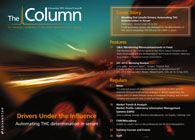Environmental Nanoparticles
Engineered nanoparticles released into the environment may affect the growth of agriculturally important crops, according to a new study published in the journal of Environmental Science and Technology.1 Scientists from The Connecticut Agricultural Experiment Station (Connecticut, USA) investigated the effect of multiwalled carbon nanotubes (MWCNTs) and C60 fullerenes on plant growth. The investigation was part of a larger project funded by the US Department of Agriculture to look at the impact of nanoparticles on agriculture. The team used gas chromatography coupled with mass spectrometry (GC?MS) in this study.
Engineered nanoparticles released into the environment may affect the growth of agriculturally important crops, according to a new study published in the journal of Environmental Science and Technology.1 Scientists from The Connecticut Agricultural Experiment Station (Connecticut, USA) investigated the effect of multiwalled carbon nanotubes (MWCNTs) and C60 fullerenes on plant growth. The investigation was part of a larger project funded by the US Department of Agriculture to look at the impact of nanoparticles on agriculture. The team used gas chromatography coupled with mass spectrometry (GC–MS) in this study.
Nanoparticles possess unique chemical and physical properties because of their small size, and can be engineered for different applications, ranging from applications in food packaging to delivery of drugs in the body. In agricultural science, nanoparticles have been investigated for stimulating expression of specific genes to increase growth, however, they have also been shown to have toxic effects. Four plant species — zucchini (Cucurbita pepo), corn (Zea mays), tomato (Solanum lycopersicum), and soybean (Glycine max) — were grown in soils containing varied concentrations of either MWCNTs or C60 fullerenes to determine the effect on pesticide uptake. After 28 days of growth, roots and shoots were analyzed GC–MS to determine uptake of weathered chlordane or DDx (DDT plus its metabolites).
Corresponding author of the study Jason White told The Column that it is widely known that adding carbon to soil decreases the availability of hydrophobic organic contaminants, therefore it was not unexpected that (with some exceptions) carbon nanotube application had the same effect. Fullerenes, however, proved to be more variable in their effect on different species. White commented: “In some cases, fullerenes slightly decreased residue uptake and translocation but in other cases, there was no effect or even an increase in pesticide residue uptake by the plants. The mechanisms driving this process remain unclear and we are working on that now. It is possible that the fullerenes are serving as a vehicle to carry pesticide residues into the plant.“ He added: “Alternatively, the fullerenes could be causing membrane damage, essentially making the roots ‘leaky’ and subsequently promoting pesticide uptake. Either way, this co-contaminant interaction may well present a food safety concern and we are actively pursuing this line of research.” - B.D.
Reference
J. White et al, Environmental Science and Technology DOI: 10.1021/es4034809 (2013).
This story originally appeared in The Column. Click here to view that issue.

Determining Enhanced Sensitivity to Odors due to Anxiety-Associated Chemosignals with GC
May 8th 2025Based on their hypothesis that smelling anxiety chemosignals can, like visual anxiety induction, lead to an increase in odor sensitivity, a joint study between the University of Erlangen-Nuremberg (Erlangen, Germany) and the Fraunhofer Institute for Process Engineering and Packaging (Freising, Germany) combined behavioral experiments, odor profile analysis by a trained panel, and instrumental analysis of odorants (gas chromatography-olfactometry) and volatiles (gas chromatography-mass spectrometry).
Investigating 3D-Printable Stationary Phases in Liquid Chromatography
May 7th 20253D printing technology has potential in chromatography, but a major challenge is developing materials with both high porosity and robust mechanical properties. Recently, scientists compared the separation performances of eight different 3D printable stationary phases.
Detecting Hyper-Fast Chromatographic Peaks Using Ion Mobility Spectrometry
May 6th 2025Ion mobility spectrometers can detect trace compounds quickly, though they can face various issues with detecting certain peaks. University of Hannover scientists created a new system for resolving hyper-fast gas chromatography (GC) peaks.

.png&w=3840&q=75)

.png&w=3840&q=75)



.png&w=3840&q=75)



.png&w=3840&q=75)







